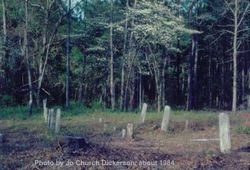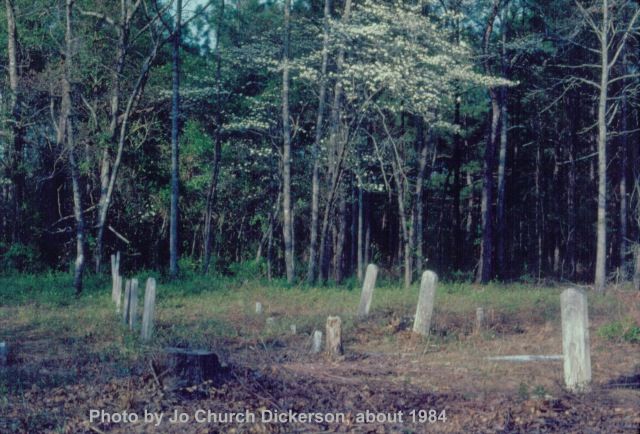No grave marker survives, but known to be buried here with his wife.
------------------------------------
Dougald Carmichael was born in Scotland about 1750.
"He was a soldier in one of the Scottish Highlander regiments of the British Army in the Revolutionary War, and after his discharge at Charleston, S.C., at the end of the war, joined his brother John Carmichael (K) in Cumberland County, N.C., near the present location of Hope Mills. There were several of the Highlander regiments with the British Army in the Southern Campaign, but they were all at Yorktown, Va., except one battalion of the Royal Highlander Immigrant Regiment, which was at Charleston until sent to the West Indies for disbanding in 1784. The members of this regiment were Scottish Highlanders that had arrived in America about the beginning of the Revolution, or were en route and were induced or forced to by British authorities. Most of its members were given the alternative of joining or being tried for treason with a certainty of execution as traitors. It is understood that Dougald (D) was en route to join his brother John, who probably came on the immigrant ship sailing from Fort William, Scotland, September 1, 1773, which brought 425 immigrants from several of the small clans in the vicinity of Loch Linnhe, including the Appin Stewart Clan, of which the Carmichael Highlanders were members. And Dougal (D) must have been a member of the Royal Highlander Emigrant Regiment, as that was the only one of the Highlander regiments in Charleston, S.C., after 1781. He reached his brother in North Carolina about 1783-4, and some time in the next two years married Flora Monroe, a member of the Monroe family of Richmond (N.C.) and Marion (S.C.) counties, who was born in Scotland. He was a brother of John Carmichael (K) and Gilbert Carmichael (F) and perhaps of one or more of the Carmichael immigrant Highlander heads of families, and cousins of the others."
"The lands acquired in Marion (now Dillon) County, S.C., by Dougald Carmichael (D) were located on both sides of the Stage Road, north of Carmichael's Bridge on Little Pee Dee river, and his home was near the old millsite about two miles from the river, occupied by him and his descendants for more than a hundred years."
"Dougald (D) and his wife died 1820-30 and are buried in the old Carmichael graveyard, one-half mile northwest of Little Pee Dee church."
------------------------------------
"Immigrant" - Symbol "D" in "The Scottish Highlander Carmichaels of the Carolinas" (written by Roderick Leland Carmichael.)
------------------------------------
No grave marker survives, but known to be buried here with his wife.
------------------------------------
Dougald Carmichael was born in Scotland about 1750.
"He was a soldier in one of the Scottish Highlander regiments of the British Army in the Revolutionary War, and after his discharge at Charleston, S.C., at the end of the war, joined his brother John Carmichael (K) in Cumberland County, N.C., near the present location of Hope Mills. There were several of the Highlander regiments with the British Army in the Southern Campaign, but they were all at Yorktown, Va., except one battalion of the Royal Highlander Immigrant Regiment, which was at Charleston until sent to the West Indies for disbanding in 1784. The members of this regiment were Scottish Highlanders that had arrived in America about the beginning of the Revolution, or were en route and were induced or forced to by British authorities. Most of its members were given the alternative of joining or being tried for treason with a certainty of execution as traitors. It is understood that Dougald (D) was en route to join his brother John, who probably came on the immigrant ship sailing from Fort William, Scotland, September 1, 1773, which brought 425 immigrants from several of the small clans in the vicinity of Loch Linnhe, including the Appin Stewart Clan, of which the Carmichael Highlanders were members. And Dougal (D) must have been a member of the Royal Highlander Emigrant Regiment, as that was the only one of the Highlander regiments in Charleston, S.C., after 1781. He reached his brother in North Carolina about 1783-4, and some time in the next two years married Flora Monroe, a member of the Monroe family of Richmond (N.C.) and Marion (S.C.) counties, who was born in Scotland. He was a brother of John Carmichael (K) and Gilbert Carmichael (F) and perhaps of one or more of the Carmichael immigrant Highlander heads of families, and cousins of the others."
"The lands acquired in Marion (now Dillon) County, S.C., by Dougald Carmichael (D) were located on both sides of the Stage Road, north of Carmichael's Bridge on Little Pee Dee river, and his home was near the old millsite about two miles from the river, occupied by him and his descendants for more than a hundred years."
"Dougald (D) and his wife died 1820-30 and are buried in the old Carmichael graveyard, one-half mile northwest of Little Pee Dee church."
------------------------------------
"Immigrant" - Symbol "D" in "The Scottish Highlander Carmichaels of the Carolinas" (written by Roderick Leland Carmichael.)
------------------------------------
Family Members
Advertisement
Records on Ancestry
Sponsored by Ancestry
Advertisement








